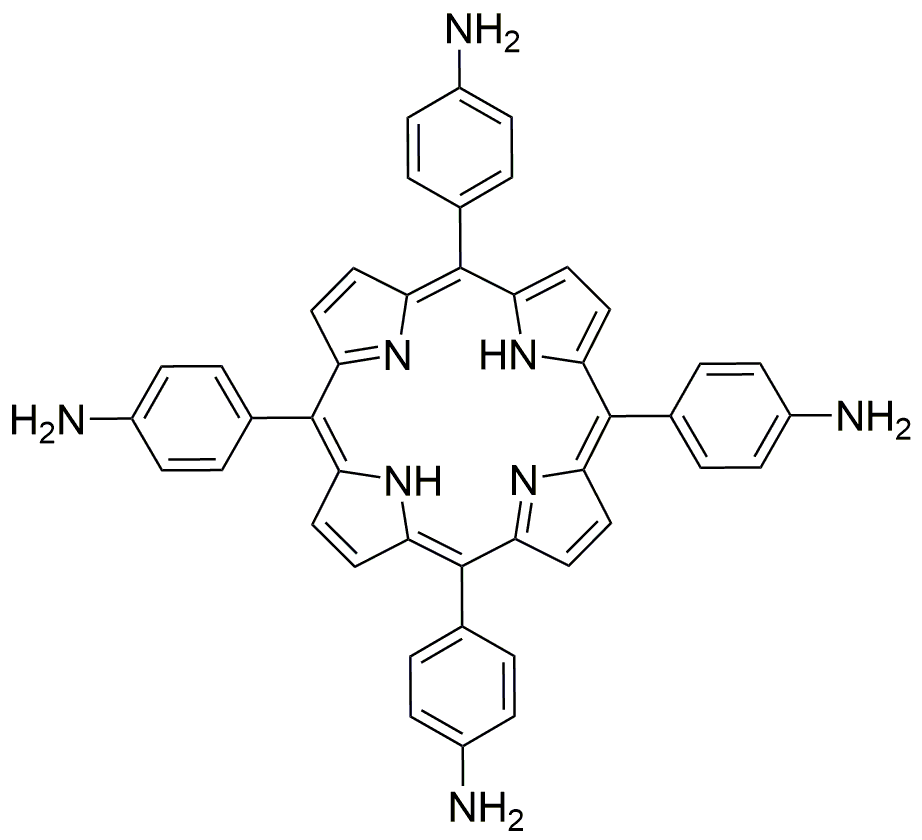5,10,15,20-Tetrakis(4-aminophenyl)porphyrin is widely utilized in research focused on:
- Photodynamic Therapy: This compound is effective in targeting cancer cells, making it a valuable agent in photodynamic therapy, where light activation leads to cell destruction.
- Solar Energy Conversion: It plays a significant role in the development of organic solar cells, enhancing light absorption and energy conversion efficiency.
- Sensors: Its unique properties allow for the creation of sensitive biosensors, useful in detecting biological molecules or environmental pollutants.
- Catalysis: The compound serves as a catalyst in various chemical reactions, particularly in organic synthesis, improving reaction rates and selectivity.
- Drug Delivery Systems: Its ability to form complexes with drugs enhances the delivery and efficacy of therapeutic agents, particularly in targeted therapies.
General Information
Properties
Safety and Regulations
Applications
5,10,15,20-Tetrakis(4-aminophenyl)porphyrin is widely utilized in research focused on:
- Photodynamic Therapy: This compound is effective in targeting cancer cells, making it a valuable agent in photodynamic therapy, where light activation leads to cell destruction.
- Solar Energy Conversion: It plays a significant role in the development of organic solar cells, enhancing light absorption and energy conversion efficiency.
- Sensors: Its unique properties allow for the creation of sensitive biosensors, useful in detecting biological molecules or environmental pollutants.
- Catalysis: The compound serves as a catalyst in various chemical reactions, particularly in organic synthesis, improving reaction rates and selectivity.
- Drug Delivery Systems: Its ability to form complexes with drugs enhances the delivery and efficacy of therapeutic agents, particularly in targeted therapies.
Documents
Safety Data Sheets (SDS)
The SDS provides comprehensive safety information on handling, storage, and disposal of the product.
Product Specification (PS)
The PS provides a comprehensive breakdown of the product’s properties, including chemical composition, physical state, purity, and storage requirements. It also details acceptable quality ranges and the product's intended applications.
Certificates of Analysis (COA)
Search for Certificates of Analysis (COA) by entering the products Lot Number. Lot and Batch Numbers can be found on a product’s label following the words ‘Lot’ or ‘Batch’.
*Catalog Number
*Lot Number
Certificates Of Origin (COO)
This COO confirms the country where the product was manufactured, and also details the materials and components used in it and whether it is derived from natural, synthetic, or other specific sources. This certificate may be required for customs, trade, and regulatory compliance.
*Catalog Number
*Lot Number
Safety Data Sheets (SDS)
The SDS provides comprehensive safety information on handling, storage, and disposal of the product.
DownloadProduct Specification (PS)
The PS provides a comprehensive breakdown of the product’s properties, including chemical composition, physical state, purity, and storage requirements. It also details acceptable quality ranges and the product's intended applications.
DownloadCertificates of Analysis (COA)
Search for Certificates of Analysis (COA) by entering the products Lot Number. Lot and Batch Numbers can be found on a product’s label following the words ‘Lot’ or ‘Batch’.
*Catalog Number
*Lot Number
Certificates Of Origin (COO)
This COO confirms the country where the product was manufactured, and also details the materials and components used in it and whether it is derived from natural, synthetic, or other specific sources. This certificate may be required for customs, trade, and regulatory compliance.


